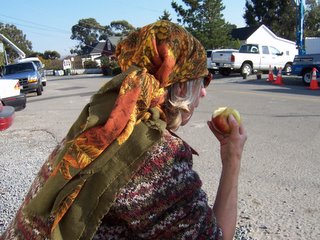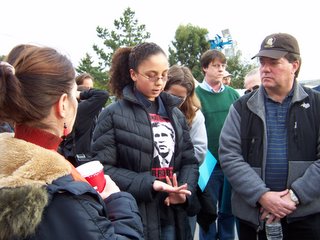 "Death comes in threes" has new meaning this morning ... .
"Death comes in threes" has new meaning this morning ... .In less than three months, three sisters; Dorothy Reid Pete, Florence Reid Lewis, and yesterday, Maybelle Reid Allen, ceased to exist -- at least in this dimension. They died in their birth order as it should be -- with Maybelle being the youngest. All lived long and productive lives. All left grieving progeny and a legacy of warmth and love.
This morning I called David to tell him of Maybelle's passing -- he was very fond of her. About ten minutes later the phone rang again and it was he. "Are you okay, Mom?" Of course he would be concerned. These were my contemporaries. The edge was coming closer. His concern for my state of mind was surely understandable. In fact, I really hadn't reacted to her death as one being pushed closer to the edge of existence, but with the sadness of loss -- as might be expected. Hadn't really identified with death in the abstract except in a casual way, I guess. Though each leaving diminishes us all, and fear of non-existence is surely a factor in creating the preciousness of life that grows with each day now. I'm acutely aware of my mortality -- but not with the kind of dread that might be anticipated if I spent much time thinking about it. In these years I'm far more involved with valuing the time left, and using it well.
I suppose it would be more frightening if I could truly imagine non-existence. I can't. Tried hard to experience "The Void" in those days when trying so hard to understand the Tibetan Buddhist belief system -- in support of Bill. Nothing took me there. No amount of meditation techniques worked for me, including the one time that he convinced me to try -- to meditate after sharing a joint. Nothing. Either my resistance was too strong, or, my intellect over rode the effects. I simply don't have the power to imagine non-being. I only know, for sure, what is here and now, and the here and now has always been quite enough.
After cradling the phone I sat quietly for a few minutes. Was aware that I'd tossed off David's concern rather casually. "I'm too busy living to worry about dying," and, "I live each day as fully as possible have no intention of leaving anything to bury!" "I plan to be all used up." Maybe it was too lightly said ... I wondered if he was reassured?
Where does this confidence come from? I don't truly know. Denial? Maybe. Each day of life now I'm aware that on that very first day of life I entered an imperfect world and that I will one day -- surely sooner than I'd wish - - leave one. I know that. I'm also convinced that there is but one life and that we're all living it. I know that the power is in the living of it with intentionality -- no drifting by -- with responsibility -- but not without mistakes or brief trips up wrong pathways. Without them we could not possibly learn to make the corrections necessary to live more productively, or to develop empathy or compassion. Such attributes come from experiencing the full variety of human experience and learning from them and moving through. That's the life process. For some (like Stanley Williams) that process is deeper and more wildly traumatic. For others, like me, it is relatively problem free in comparison, but not without its share of pain and suffering, but manageable.
Though my beliefs are still ever-changing, at the moment I'm sure that each of us born into this life stream from whichever "tributaries," have the power to either enrich the collective existence or impoverish it. We had no choice about how we entered, and through whom, but how we use the time is for each to determine. Had I been born in the first centuries or the Middle Ages -- had I been born to wealth and privilege or a life of peonage -- I would be someone else. And in a way, I was. We all were. Maybe that "star stuff" that connects us all is what science has named DNA. I carry the DNA of slaves; Celestine of No Last Name, Leontine "Mammå" Allen Breaux, but also (from one fascinating possibility that turned up in my research), Sacagewea's son, Jean Pierre Charbonneau; and that French Lieutenant, Louis Charbonnet, who fought Toussaint L'overture in the Haitian Revolution and who later settled in New Orleans to begin the long line of Creole Americans who contributed to history in ways both large and small.
I have little belief in reincarnation per se, but I do have a strong sense of having blood connections to the lineage out of which I've come, and of the character of the lives that I will have influenced upon leaving. My immortality is in the children and grandchildren whose lives will have been marked with the quality of my own life, for good or ill -- and how they remember me -- as have the lives of Mammå, and Aunt Vivian, and Aunt Alice, and my imaginings about the Sacagewea connection, and my father, Dorson Louis Charbonnet, and his steadfast pride in family; all contributors to mine.
Nothing is lost, ever. At least not until the bomb is dropped and all life is obliterated from the planet. And, life will remain imperfect -- a laboratory for each succeeding generation to shape this wondrous collective existence through the living of it.
I truly believe that every day left on my Calendar of Destiny must continue to be lived fully and that the moment I stop -- I will be simply waiting to die. May I be blessed with a quick and relatively pain-free ending.
This is one of those days when I wish fervently that I believed in an afterlife and that Dorothy and Flossie have met and ushered Maybelle into their heavenly circle where, together, they will join the other Reid's who preceded them into eternity. And perhaps this is so.
Would that I, too, could believe ... .
Photo: Another picture of the lovely stained glass windows in the little Chapel at Sea Ranch. Spent some time this morning with eyes closed -- imagining myself there again -- recalling images of Maybelle and her family. She left to me the gift of a strong and loving friendship with her youngest son, who has become one of my closest and dearest friend -- across the generations.




